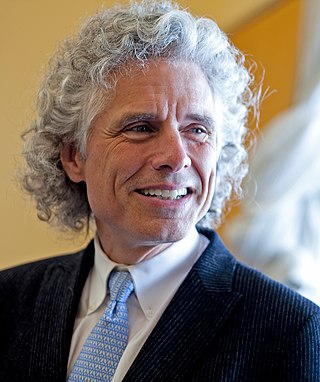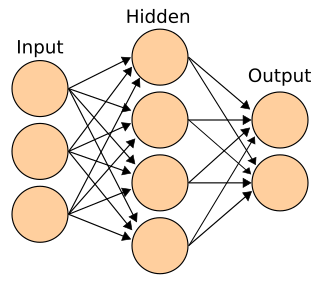Related Research Articles

Cognitive science is the interdisciplinary, scientific study of the mind and its processes with input from linguistics, psychology, neuroscience, philosophy, computer science/artificial intelligence, and anthropology. It examines the nature, the tasks, and the functions of cognition. Cognitive scientists study intelligence and behavior, with a focus on how nervous systems represent, process, and transform information. Mental faculties of concern to cognitive scientists include language, perception, memory, attention, reasoning, and emotion; to understand these faculties, cognitive scientists borrow from fields such as linguistics, psychology, artificial intelligence, philosophy, neuroscience, and anthropology. The typical analysis of cognitive science spans many levels of organization, from learning and decision to logic and planning; from neural circuitry to modular brain organization. One of the fundamental concepts of cognitive science is that "thinking can best be understood in terms of representational structures in the mind and computational procedures that operate on those structures."

Steven Arthur Pinker is a Canadian-American cognitive psychologist, psycholinguist, popular science author, and public intellectual. He is an advocate of evolutionary psychology and the computational theory of mind.
Psycholinguistics or psychology of language is the study of the interrelation between linguistic factors and psychological aspects. The discipline is mainly concerned with the mechanisms by which language is processed and represented in the mind and brain; that is, the psychological and neurobiological factors that enable humans to acquire, use, comprehend, and produce language.

Connectionism refers to both an approach in the field of cognitive science that hopes to explain mental phenomena using artificial neural networks (ANN) and to a wide range of techniques and algorithms using ANNs in the context of artificial intelligence to build more intelligent machines. Connectionism presents a cognitive theory based on simultaneously occurring, distributed signal activity via connections that can be represented numerically, where learning occurs by modifying connection strengths based on experience.
Elizabeth Ann Bates was a professor of cognitive science at the University of California, San Diego. She was an internationally renowned expert and leading researcher in child language acquisition, psycholinguistics, aphasia, and the neurological bases of language, and she authored 10 books and over 200 peer-reviewed articles and book chapters on these subjects. Bates was well known for her assertion that linguistic knowledge is distributed throughout the brain and is subserved by general cognitive and neurological processes.
Modularity of mind is the notion that a mind may, at least in part, be composed of innate neural structures or mental modules which have distinct, established, and evolutionarily developed functions. However, different definitions of "module" have been proposed by different authors. According to Jerry Fodor, the author of Modularity of Mind, a system can be considered 'modular' if its functions are made of multiple dimensions or units to some degree. One example of modularity in the mind is binding. When one perceives an object, they take in not only the features of an object, but the integrated features that can operate in sync or independently that create a whole. Instead of just seeing red, round, plastic, and moving, the subject may experience a rolling red ball. Binding may suggest that the mind is modular because it takes multiple cognitive processes to perceive one thing.
The language of thought hypothesis (LOTH), sometimes known as thought ordered mental expression (TOME), is a view in linguistics, philosophy of mind and cognitive science, forwarded by American philosopher Jerry Fodor. It describes the nature of thought as possessing "language-like" or compositional structure. On this view, simple concepts combine in systematic ways to build thoughts. In its most basic form, the theory states that thought, like language, has syntax.
Neurophilosophy or philosophy of neuroscience is the interdisciplinary study of neuroscience and philosophy that explores the relevance of neuroscientific studies to the arguments traditionally categorized as philosophy of mind. The philosophy of neuroscience attempts to clarify neuroscientific methods and results using the conceptual rigor and methods of philosophy of science.
The cognitive revolution was an intellectual movement that began in the 1950s as an interdisciplinary study of the mind and its processes. It later became known collectively as cognitive science. The relevant areas of interchange were between the fields of psychology, linguistics, computer science, anthropology, neuroscience, and philosophy. The approaches used were developed within the then-nascent fields of artificial intelligence, computer science, and neuroscience. In the 1960s, the Harvard Center for Cognitive Studies and the Center for Human Information Processing at the University of California, San Diego were influential in developing the academic study of cognitive science. By the early 1970s, the cognitive movement had surpassed behaviorism as a psychological paradigm. Furthermore, by the early 1980s the cognitive approach had become the dominant line of research inquiry across most branches in the field of psychology.
In the field of psychology, nativism is the view that certain skills or abilities are "native" or hard-wired into the brain at birth. This is in contrast to the "blank slate" or tabula rasa view, which states that the brain has inborn capabilities for learning from the environment but does not contain content such as innate beliefs. This factor contributes to the ongoing nature versus nurture dispute, one borne from the current difficulty of reverse engineering the subconscious operations of the brain, especially the human brain.
Neuroconstructivism is a theory that states that phylogenetic developmental processes such as gene–gene interaction, gene–environment interaction and, crucially, ontogeny all play a vital role in how the brain progressively sculpts itself and how it gradually becomes specialized over developmental time.
Developmental cognitive neuroscience is an interdisciplinary scientific field devoted to understanding psychological processes and their neurological bases in the developing organism. It examines how the mind changes as children grow up, interrelations between that and how the brain is changing, and environmental and biological influences on the developing mind and brain.
Jeffrey Locke Elman was an American psycholinguist and professor of cognitive science at the University of California, San Diego (UCSD). He specialized in the field of neural networks.
Evolutionary psychology seeks to identify and understand human psychological traits that have evolved in much the same way as biological traits, through adaptation to environmental cues. Furthermore, it tends toward viewing the vast majority of psychological traits, certainly the most important ones, as the result of past adaptions, which has generated significant controversy and criticism from competing fields. These criticisms include disputes about the testability of evolutionary hypotheses, cognitive assumptions such as massive modularity, vagueness stemming from assumptions about the environment that leads to evolutionary adaptation, the importance of non-genetic and non-adaptive explanations, as well as political and ethical issues in the field itself.
In linguistics, the innateness hypothesis holds that humans are born with at least some knowledge of linguistic structure. On this hypothesis, language acquisition involves filling in the details of an innate blueprint rather than being an entirely inductive process. The hypothesis is one of the cornerstones of generative grammar and related approaches in linguistics. Arguments in favour include the poverty of the stimulus, the universality of language acquisition, as well as experimental studies on learning and learnability. However, these arguments have been criticized, and the hypothesis is widely rejected in other traditions such as usage-based linguistics. The term was coined by Hilary Putnam in reference to the views of Noam Chomsky.
Domain-specific learning theories of development hold that we have many independent, specialised knowledge structures (domains), rather than one cohesive knowledge structure. Thus, training in one domain may not impact another independent domain. Domain-general views instead suggest that children possess a "general developmental function" where skills are interrelated through a single cognitive system. Therefore, whereas domain-general theories would propose that acquisition of language and mathematical skill are developed by the same broad set of cognitive skills, domain-specific theories would propose that they are genetically, neurologically and computationally independent.
Interactive Specialization is a theory of brain development proposed by the British developmental cognitive neuroscientist Mark Johnson, formerly head of the Centre for Brain and Cognitive Development at Birkbeck, University of London, London and who is now Head of Psychology at the University of Cambridge.
Mark Henry Johnson is a British cognitive neuroscientist who, since October 2017, has been Professor of Experimental Psychology and Head of the Department of Psychology at the University of Cambridge. He is a Fellow of the Association for Psychological Science.
Annette Karmiloff-Smith CBE FBA FMedSci (1938–2016) was a professorial research fellow at the Developmental Neurocognition Lab at Birkbeck, University of London. Before moving to Birbeck, she was Head of the Neurocognitive Development Unit at Institute of Child Health, University College, London. She was an expert in developmental disorders, with a particular interest in Williams syndrome.
The East Pole–West Pole divide in the fields of cognitive psychology and cognitive neuroscience is an intellectual schism between researchers subscribing to the nativist and empiricist schools of thought. The term arose from the fact that much of the theory and research supporting nativism, modularity of mind, and computational theory of mind originated at several universities located on the East Coast, including Harvard University, the University of Michigan, Massachusetts Institute of Technology, and Tufts University. Conversely, much of the research and theory supporting empiricism, emergentism, and embodied cognition originated at several universities located on the West Coast, including the University of California, Berkeley, the Salk Institute, and, most notably, the University of California, San Diego. In reality, the divide is not so clear, with many universities and scholars on both coasts supporting each position, as well as more moderate positions in between the two extremes. The phrase was coined by Jerry Fodor at an MIT conference on cognition, at which he referred to another researcher as a "West Coast theorist," apparently unaware that the researcher worked at Yale University.
References
- ↑ Elman, Jeffrey; et al. (1996). Rethinking Innateness: A Connectionist Perspective on Development . Cambridge, MA: MIT Press. ISBN 978-0-262-55030-7.
- ↑ Google Scholar
- ↑ "Millenium Project Nominations". Archived from the original on 2008-06-24. Retrieved 2008-06-05.
- ↑ Pinker S., Bloom P. (1990). "Natural language and natural selection". Behavioral and Brain Sciences. 13 (4): 707–784. CiteSeerX 10.1.1.116.4044 . doi:10.1017/S0140525X00081061.